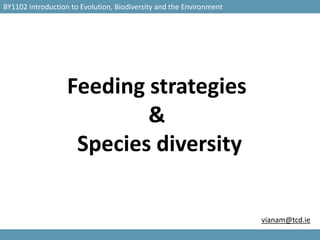
4 invertebrates
- 1. BY1102 Introduction to Evolution, Biodiversity and the Environment Feeding strategies & Species diversity vianam@tcd.ie
- 2. BY1102 Introduction to Evolution, Biodiversity and the Environment 1. There are 4 main feeding types of animals. Which are they and give examples. 1. Suspension/filter feeders: feed on particles suspended in the surrounding water 2. Fluid feeders: feed on fluids (e.g. blood, nectar) of another organisms 3. Substrate feeders: feed on what they live in (soil) 4. Bulk feeders: eat pieces of other organisms or swallow them whole
- 3. BY1102 Introduction to Evolution, Biodiversity and the Environment 2. What does each phylum eat? – Name the animal phylum
- 4. BY1102 Introduction to Evolution, Biodiversity and the Environment 2. What does each phylum eat? – Main characteristics Lack symmetry Lack true tissues Radial symmetry Diploblastic (2 germ layers) Embryonic development (anus from blasopore) •Bilateral symmetry Protostome development •Triploblastic (mouth from blastopore) •Coelom (body cavity)
- 5. BY1102 Introduction to Evolution, Biodiversity and the Environment 2.1 Give an example of an animal for each phylum 2.2 What does each phylum eat?
- 6. BY1102 Introduction to Evolution, Biodiversity and the Environment 2. What does each phylum eat? Give an example of an animal for each phylum Porifera: Glass or calcareous sponges or demosponges Filter-feeding Small particles in water e.g. small crustaceans bacteria Ctenophora: e.g. Sea gooseberries & comb jellies Bulk feeders Zooplankton e.g. fish eggs, copepods, amphipods, larvae
- 7. BY1102 Introduction to Evolution, Biodiversity and the Environment Cnidaria: e.g. anemones, jellyfish and corals Bulk feeders Zooplankton e.g. small crustacean Equinodermata: e.g. starfish, sea urchins, sea cucumbers Filter-feeding or Substrate feeders e.g. small particles in water or grazers
- 8. BY1102 Introduction to Evolution, Biodiversity and the Environment Chordata: e.g. humans and other mammals, birds, fish, frogs, sea squirts... All types of feeders Platyhelminthes : a.k.a. flatworms; e.g. Taenia, planarian, flukes and tapeworms All types of feeders e.g. carnivorous / parasites (eg. tissues, small investebrates)
- 9. BY1102 Introduction to Evolution, Biodiversity and the Environment Brachiopoda: a.ka. lamp shells Filter-feeding e.g. fine particles in water Mollusca: e.g. Octopus, clams, snails All types e.g. Herbivores, carnivores, filter feeders
- 10. BY1102 Introduction to Evolution, Biodiversity and the Environment Annelida: e.g. ringworms: earthworm, leech, lugworm... Fluid & substrate feeders e.g. Blood or decomposers (undecayed leaf and other plant matter) Nematoda: Roundworms e.g. C. elegans All feeding types e.g. Decomposers: bacteria and detritus / carnivores: small crustaceans/or parasites
- 11. BY1102 Introduction to Evolution, Biodiversity and the Environment Arthropoda: e.g. Insects (eg. mosquitos), spiders, crustaceans (lobsters) All types of feeders e.g. Blood, carnivores, herbivores...
- 12. BY1102 Introduction to Evolution, Biodiversity and the Environment 3. Describe the adaptations of herbivores and plants Plant Herbivores 1. Chemical defences 1. Chemical defences • chemical compounds that are toxic • enzymes that counteract toxins or and repel or reduce digestibility (e.g. sensors (less toxins and higher quality nicotine and cocaine) nutrients) 2. Physical defences 2. Physical defences • specialized mouthparts, teeth, hard • thorns, spines tongues, fewer soft body parts 3. Metabolic/behavioural adaptations 3. Bodyguards • seasonality, symbioses with e.g. • induced or constitutive bacteria to help digestion, low metabolic rates
- 13. BY1102 Introduction to Evolution, Biodiversity and the Environment 4. Describe the adaptations of predators and prey Prey Predator 1. Camouflage 1. Senses • Species resembles its background. • Species resembles its background. 2. Senses 2. Hunting strategies • Sight, hearing, smell • Stalk, sit&wait, group hunting, lures 3. Warning signals 3. Physical adaptations • Noises, visual/smell signals (e.g. shunk) • Strength, jaws/claws, stamina, tongues 4. Defensive ‘weapons’ 4. Behavioural adaptations • Chemical defenses, weapons • Speed, communication (claws/teeth) 5. Behavioural adaptations • Living in groups, hiding, mimicry
- 14. BY1102 Introduction to Evolution, Biodiversity and the Environment 5. Describe the evolutionary consequences of predator-prey coevolution Describe coevolution. - two (or more)species reciprocally affect each other’s evolution. Predation influences the fitness of both predators and prey. Individuals must both feed and avoid being eaten to survive and reproduce. Genetically-determined traits that improve an organism’s ability to survive and reproduce will be passed on to its offspring. Traits associated with improved predation for predators and escaping predation for prey tend to be positively selected by natural selection.
- 15. BY1102 Introduction to Evolution, Biodiversity and the Environment Read: “The Maintenance of Species Diversity”
- 16. BY1102 Introduction to Evolution, Biodiversity and the Environment Next week: Study week